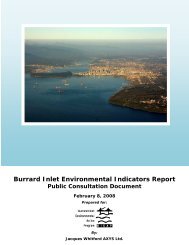Biodiversity Conservation - the BIEAP and FREMP Website
Biodiversity Conservation - the BIEAP and FREMP Website
Biodiversity Conservation - the BIEAP and FREMP Website
Create successful ePaper yourself
Turn your PDF publications into a flip-book with our unique Google optimized e-Paper software.
Discussion<br />
Several main points can be seen in reviewing <strong>the</strong><br />
Strategic Directions document <strong>and</strong> <strong>the</strong> comments<br />
made in <strong>the</strong> Forum.<br />
Most conspicuous is <strong>the</strong> participants’ agreement with<br />
<strong>the</strong> Strategic Directions document, both in its general<br />
outline <strong>and</strong> in <strong>the</strong> details it presented. Discussions<br />
were about how to make <strong>the</strong> various strategies <strong>and</strong><br />
actions take place. The agreement with <strong>the</strong> document<br />
was occasionally explicit but was mostly implicit. It<br />
showed in <strong>the</strong> coherence of comments made with <strong>the</strong><br />
logic <strong>and</strong> <strong>the</strong> directions offered by <strong>the</strong> report. Only one<br />
comment was made about <strong>the</strong> phrasing of one of <strong>the</strong><br />
Opportunities for Action.<br />
Although <strong>the</strong> Forum participants were all interested<br />
in biodiversity, <strong>the</strong>ir comments showed <strong>the</strong>y were<br />
not necessarily knowledgeable about <strong>the</strong> <strong>Biodiversity</strong><br />
<strong>Conservation</strong> Strategy Partnership nor about<br />
<strong>the</strong> Strategic Directions document. A number of<br />
participants commented that <strong>the</strong>y had come to <strong>the</strong><br />
Forum to learn. Although all participants had received<br />
<strong>the</strong> Strategic Directions document in advance of <strong>the</strong><br />
Forum, not everyone had fully absorbed <strong>the</strong> materials<br />
or recognized <strong>the</strong> comprehensiveness of <strong>the</strong> Strategic<br />
Directions <strong>and</strong> <strong>the</strong>ir associated actions. Thus both<br />
<strong>the</strong>y <strong>and</strong> o<strong>the</strong>r readers of <strong>the</strong> document could benefit<br />
from additional details <strong>and</strong> support concerning actions<br />
for biodiversity conservation. Some such information<br />
is provided in <strong>the</strong> Exploring <strong>the</strong> Next Steps for Action<br />
section above, which makes information from <strong>the</strong><br />
Partnership more conspicuously available. The Education/<br />
Communications Strategic Direction had more comments<br />
than any o<strong>the</strong>r Strategic Direction, reflecting many felt<br />
needs. Obtaining relevant information is a major issue<br />
related to taking action concerning biodiversity.<br />
A strong feature of <strong>the</strong> comments of <strong>the</strong> Forum<br />
participants is <strong>the</strong> extent to which <strong>the</strong>y repeated ideas<br />
which are among <strong>the</strong> Strategic Directions document. Their<br />
comments confirm <strong>the</strong> breadth <strong>and</strong> comprehensiveness of<br />
<strong>the</strong> Partnership’s work. The participants were particularly<br />
concerned with <strong>the</strong> <strong>the</strong>mes of cooperation, collaboration,<br />
information sharing <strong>and</strong> education, in addition to <strong>the</strong><br />
technical information <strong>and</strong> managerial steps associated<br />
with biodiversity conservation. Continuing <strong>the</strong> processes<br />
identified by <strong>the</strong> Strategic Directions <strong>and</strong> <strong>the</strong> Opportunities<br />
for Action appears relevant to all participants.<br />
Cattail, Typha latifolia, also known as bulrush or reedmace, is<br />
a primitive plant dating back to <strong>the</strong> dinosaur era. It is one of<br />
B.C’s most prominent wetl<strong>and</strong> species <strong>and</strong> is easily spotted in<br />
<strong>the</strong> Fraser River estuary. Cattail plays an essential ecological<br />
role, providing habitat for fish, waterfowl, waders, red-winged<br />
blackbirds <strong>and</strong> small mammals such as muskrats.<br />
Strategic Directions for <strong>Biodiversity</strong> <strong>Conservation</strong> in <strong>the</strong> Metro Vancouver Region | Forum Proceedings: Key Points <strong>and</strong> Potential Action Steps<br />
33
















